1: anterior edge of large oral lappet on head.
2: eye.
3: mantle edge.
4: transparent mantle skirt over mantle cavity containing no ctenidium or special respiratory capillaries. Broad lateral tracts of foot-surface may have accessory respiratory function as blood comes there to body-surface under very thin epithelium through which respiratory interchange might easily be possible (Morton, 1955).
5: horseshoe-shape loop of intestine.
6: large, rounded or bluntly lobate, orange lobules of digestive gland.
7: stomach with rotating protostyle of mucus and faeces, similar to that of bivalves, most primitive yet described in a pulmonate (Morton, 1955). Anterior of stomach tapers into intestine.
8: blackish internal organs visible through translucent body.
9: small kidney in front of looped intestine opens into pallial cavity with no water current to carry discharges out of cavity ; probably assisted by accessory excretion from amoebocytes in broad lateral tracts of foot.
10: internal blackish sclerotized jaw helps radula to gather food particles.
11: ovotestis; hermaphrodite organ serving sequentially as testis and ovary.
12: sole of foot.
Shell length 2.3 mm. North Yorkshire, September 2014. (leg. Jan Light.)
10 Otina ovata

